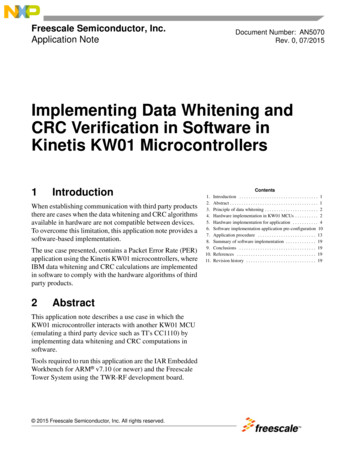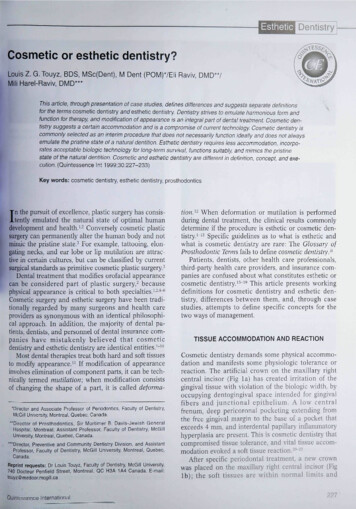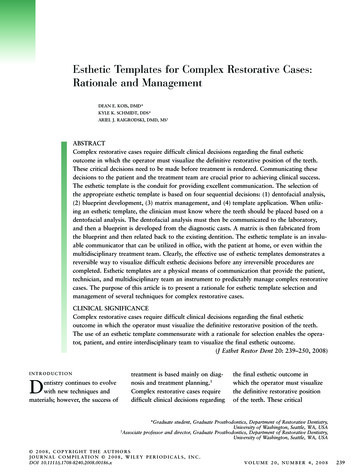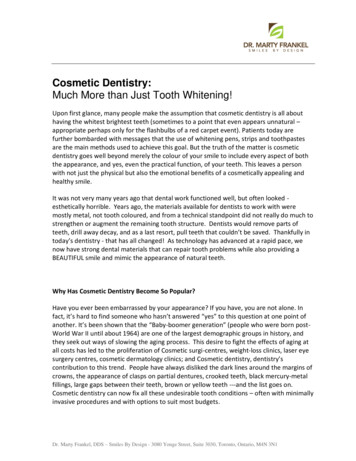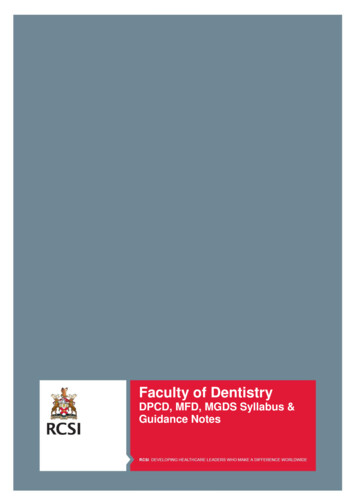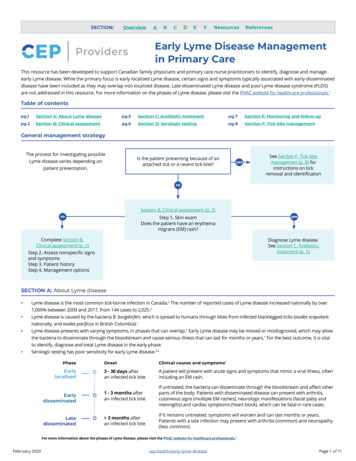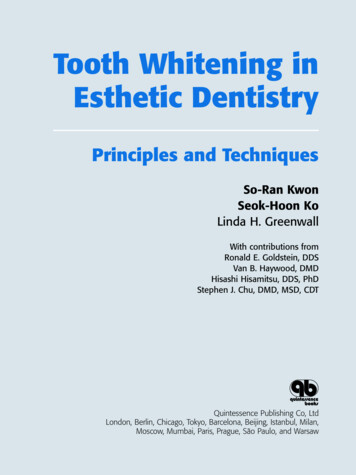
Transcription
Tooth Whitening inEsthetic DentistryPrinciples and TechniquesSo-Ran KwonSeok-Hoon KoLinda H. GreenwallWith contributions fromRonald E. Goldstein, DDSVan B. Haywood, DMDHisashi Hisamitsu, DDS, PhDStephen J. Chu, DMD, MSD, CDTQuintessence Publishing Co, LtdLondon, Berlin, Chicago, Tokyo, Barcelona, Beijing, Istanbul, Milan,Moscow, Mumbai, Paris, Prague, São Paulo, and Warsaw
TABLE OF CONTENTSChapter 1Diagnosis and treatment planning . . . . . . . . . . . . . . . . . . . . . . . . . . . . . . 1Tooth whitening flowchartDiagnosis for tooth whiteningChapter 2Non-vital tooth whitening. . . . . . . . . . . . . . . . . . . . . . . . . . . . . . . . . . . . . 25Walking bleach techniqueThermocatalytic bleachingInside-outside bleachingLight-activated bleaching of non-vital teethChapter 3140Maintenance . . . . . . . . . . . . . . . . . . . . . . . . . . . . . . . . . . . . . . . . . . . . . . . 147Parameters of success and failureLongevity of tooth whiteningMaintenance careChapter 10124132Safety and sensitivity. . . . . . . . . . . . . . . . . . . . . . . . . . . . . . . . . . . . . . . . 139Side effects of tooth whiteningChapter 9116116117Tooth whitening in esthetic dentistry . . . . . . . . . . . . . . . . . . . . . . . . . . 123Clinical classification of tooth whiteningTetracycline discolorationsChapter 8104104105106109Gingival bleaching . . . . . . . . . . . . . . . . . . . . . . . . . . . . . . . . . . . . . . . . . . 115Surgical removal of discolored gingivaChemical removal of discolored gingivaLaser treatment of discolored gingivaChapter 77887889396100Microabrasion . . . . . . . . . . . . . . . . . . . . . . . . . . . . . . . . . . . . . . . . . . . . . 103Indications and contraindicationsAdvantages and disadvantagesMicroabrasion materialsMicroabrasion techniqueMicroabrasion and other treatmentsChapter 652545556566672Power whitening . . . . . . . . . . . . . . . . . . . . . . . . . . . . . . . . . . . . . . . . . . . . 77EquipmentAdvantages and disadvantages of power whiteningFactors that affect whiteningPower whitening techniquePower whitening modificationsTroubleshooting in power whiteningChapter 530414144Home whitening. . . . . . . . . . . . . . . . . . . . . . . . . . . . . . . . . . . . . . . . . . . . . 51Mechanism of tooth whiteningHome whitening materialsOver-the-counter (OTC) productsIndications and contraindications of home whiteningHome whitening techniqueFabrication of the traysPatient satisfactionChapter 422148151151History of tooth whitening (Linda H. Greenwall) . . . . . . . . . . . . . . . . 155Index . . . . . . . . . . . . . . . . . . . . . . . . . . . . . . . . . . . . . . . . . . . . . . . . . . . . . 165V
Editors and ContributorsEditorsDr. So-Ran Kwon, DDS, MS, PhDMichigan Dental ClinicSeoul, KoreaDr. Seok-Hoon Ko, DDS, MS, MSPresidentInternational Federation of Esthetic DentistrySeoul, KoreaDr. Linda GreenwallBDS, MGDS RCS, MRD RCS, MSc, FGDPLondon, UKContributorsRonald E. Goldstein, DDSClinical Professor of Oral RehabilitationSchool of Dentistry, Medical College of GeorgiaAugusta, Georgia, USAVan B. Haywood, DMDProfessor and Director of Dental ContinuingEducationDepartment of Oral RehabilitationSchool of Dentistry, Medical College of GeorgiaAugusta, Georgia, USAHisashi Hisamitsu, DDS, PhDProfessor and Chairman, Department of ClinicalCariology and EndodontologyShowa University School of Dentistry, Tokyo, JapanStephen J. Chu, DMD, MSD, CDTDirector, Advanced CDE Program in AestheticDentistryClinical Associate Professor, Department ofPeriodontics and Implant DentistryNew York University College of Dentistry, USAVI
ForewordThe publication of the English translation of Tooth Whitening in Esthetic Dentistry by the esteemed authors,Drs. Seok-Hoon Ko and So-Ran Kwon, is a major contribution to the dental literature. I have been so proudof the great progress that we have seen in esthetic dentistry in Korea, and so much of it is due to thisdynamic husband and wife duo. Dr. So-Ran Kwon has become one of the most knowledgeable authorities on tooth whitening, as she has both researched and lectured considerably on the topic.In most every study that we have seen regarding patient requests for dental services, tooth whitening isat the top of the list. And of tooth whitening options, certainly bleaching is the most conservative and economical treatment available. Of course, when bleaching isn’t effective, composite resin bonding, porcelainlaminates, or all-ceramic crowns are excellent alternatives. But the first and most conservative approach toany treatment plan should always be to consider whether bleaching can serve as the ideal treatmentoption - or at least aid in the whitening of adjacent or opposing teeth when laminates, bonding or crownsare selected.This book dissects the subject quite well and gives both young and seasoned dentists alike an excellentapproach to the topic. It deals not only with various whitening techniques, but also with the occurrence ofsensitivity in certain situations and the maintenance required to keep the teeth as light as possible. Overall,this is a particularly well thought-out and beautifully illustrated text.Another valuable inclusion in the book is the “Tooth Whitening Communication Tool,” which consists ofbefore and after bleaching results. It is a great demonstration tool, and patients will welcome the realisticpictures showing accurate bleaching shade changes in response to different types of tooth stains.I compliment Drs. Seok-Hoon Ko and So-Ran Kwon on their ongoing research and clinical efforts, as wellas on the tremendous amount of time they took to complete this textbook.The international profession is indebted to you.Ronald E. Goldstein, DDSVII
Preface‘Esthetic dentistry starts with tooth whitening’.Fulfilling the desire and demand to have a bright and white smile is the ultimate goal. A bright smile notonly presents a healthy and beautiful impression, but also increases one’s interest in oral hygiene care andhealth, allowing a person to have more social self-confidence. Being able to make contributions to such asmile is one of the most precious privileges of the dentist.This book is intended as a guideline for future and practicing dentists as well as dental hygienists. Itdemonstrates the wide scope of tooth whitening procedures and the challenges they pose with a multitude of clinical photographs and illustrations, emphasizing the efficacy and limitations of whitening treatments in various clinical situations.The first chapter starts with a systematic approach to proper diagnosis and treatment planning, both ofwhich are essential for successful whitening treatment. Chapters 2, 3 and 4 describe the basic principlesand step-by-step procedures of non-vital tooth whitening, home whitening and power whitening and propose new and specific solutions for more efficient treatment. Chapters 5, 6 and 7 demonstrate how tocombine tooth whitening with other treatment modalities, such as microabrasion, gingival bleaching andesthetic bonded restorations, to achieve ultimate esthetics in our daily practice. Specific safety and sensitivity issues have been addressed to help dentists prevent and overcome problems that can be encountered in certain situations. Recommendations on how to maintain the whitened tooth color after completion of treatment to ensure long-lasting patient satisfaction are also made. The last chapter, a valuable contribution from Dr. Linda H. Greenwall on the history of tooth whitening, provides a concise timetable ofimportant events that have contributed to the advancement of tooth whitening. Finally, the supplementaryvolume provides before and after pictures, arranged according to different clinical situations, that show thedentist and the patient what can be expected after the treatment. It is one of the highlights of this book!Tooth whitening is indeed a very conservative and economical treatment that can benefit both the patientand the dentist. It is our hope that this book will encourage the readers to incorporate tooth whiteningmore actively in daily practice, giving more patients a whiter and brighter smile.
AcknowledgementsIt was a pleasure to write as a husband and wife team. However, our book would not exist without support and encouragement from many individuals, to whom we would like to express our highest appreciation:Sincere thanks to our co-author, Dr. Linda H. Greenwall, for contributing a precious chapter on the History ofTooth Whitening and for reviewing the English translation. Her constant advice and support was invaluable.Thanks, also to Dr. Ronald Goldstein for laying the foundation for Tooth Whitening and Esthetic Dentistryfor all of us to grow roots on. He is a true pioneer and will be our precious mentor eternally. We are grateful to him, in particular, for the foreword and for other contributions.We thank Dr. Van Haywood, Dr. Hisashi Hisamitsu and Dr. Stephen Chu for their friendship and significantcontributions and for their continuous interest in furthering our activities.Thanks for excellent guidance during the graduate program to Dr. Seung-Jong Lee and Dr. Chan YoungLee at Yonsei University from Dr. So-Ran Kwon, and to Dr. Brien Lang, Dr. William Kotowicz and Dr. JosephClayton at the University of Michigan from Dr. Seok-Hoon Ko.We would also like to express our gratitude to:– Our teachers, who exerted an extensive and positive influence not only on our thoughts on dentistry,but also on our personal lives: Prof. Masahiro Kuwata, Dr. Jae-Hyun Lee, and Dr. Heung-Ryul Yoon.– Our colleagues, Dr. Dan Fischer, Mr. Dirk Jeffs, Dr. Ryuichi Kondo, Dr. Robert Dharma, Dr. BaldwinMarchack and Mr. Ken Beacham, who gave us their support and the chance to lecture in the field of ToothWhitening and gave us insight into many other fields.– The leaders of the International Federation of Esthetic Dentistry, whose friendship is of finest value tous: Drs. Takao Maruyama, Ronald Goldstein, Philippe Gallon, Peter Tay, Dan Nathanson, Jose Moura, RafiRomano, Wynn Okuda and Akira Senda.– Dr. Yoon Lee for performing the research on the sealed bleaching technique and for her support in initiating the book.IX
– Our dental staff, who quietly stood beside us all the way, giving us their unswerving assistance: Mr. SangWoo Lee, Ms. Hae Sun Jung, Ms. Ji Young Oh.– Our secretary, Ms.Yoo-Min Kim, without whom it would have been impossible to complete this book.– Dr. Galip Gurel, our dearest friend, who gave us bounteous inspiration and was the vital force for publication of this book. He will be our special messenger forever to whom we are indebted.Our abiding gratitude to Mr. Wolfgang-Horst Haase of Quintessence Publishing, who trusted in us and gavethe final consent for publication of the book.Sincere thanks to Mr. Bernd Burkart, Head of the Production Department, and the administrative and production staff of Quintessence Publishing Co. for their expertise in publication of the book.We address our gratitude to Dr. Myung Oh, Immediate Past Deputy Prime Minister and Past Minister ofScience and Technology of South Korea and current President of Konkuk University, for his long-termencouragement and for teaching us to become a personality, both socially and as a dentist.Last but not least, our love to our parents, Yong Hyun Kwon & Che Sook Chang and Ahn-Soo Ko & SunOk Na, who took us as we are and gave us their unconditional love and attention.This book is dedicated to our precious children, Youngwon-Julia and Youngmin-Joseph. The best is for usto say that we thank God for them, the most beautiful gifts in our lives.Finally, we sincerely thank God for His guidance and blessings in our life.Dr. So-Ran Kwon (President, Korean Bleaching Society)Dr. Seok-Hoon Ko (Past-President, International Federation of Esthetic Dentistry)X
chapter1Diagnosis andtreatment planning
CHAPTER 2Light-activated bleaching of non-vital teethCP irradiation method (contribution from Hisashi Hisamitsu)A 10% carbamide peroxide gel is placed on the labial surface and into the access cavity of the non-vitaltooth and light activated from the buccal and lingual side (Fig. 2-15). This technique is termed the “CPirradiation method” or “Hisamitsu method” after its developer. The advantage of this technique is that thediscoloration of the non-vital tooth improves on the day of treatment, dispensing with the need for multiple visits (Figs. 2-16a and b). The mechanism of shade improvement through light activation is unclear. Ithas been suggested that the increase in temperature due to irradiation catalyzes the breakdown intohydrogen peroxide and permeation into the dentin.Fig. 2-15 CP irradiation method.10% CPXenon lightactivationaFig. 2-16 Discoloration of the upper left central incisor.a. Before CP irradiation.b. After CP irradiation (same day).44b
NON-VITAL TOOTH WHITENINGLight activation with power whitening gelsDiscolored abutment teeth or discolored roots can be a dilemma to the esthetic dentist. In these delicatesituations, a resin barrier can be placed around the non-vital abutment tooth followed by application of apower whitening gel, which is then activated with a light source (Figs. 2-17 and 2-18).Fig. 2-17 Power whitening gel with light activation.a. Power whitening gel is placed on the discolored abutment tooth after proper resin barrier placement.b. Palatal view.Fig. 2-18 Discoloration of abutment tooth.a. Dark abutment tooth with a metal post and core.b. After proper isolation of the gingiva, a highly concentrated bleaching gel is placed onto the tooth and activatedwith a light source. Non-vital bleaching techniques include the walking bleach technique, thermocatalytic bleaching,inside-outside bleaching, and light-activated bleaching methods. If the protocols are followed properly, all of these techniques provide safe and effective bleaching results with minimal tooth reduction.45
The publication of the English translation of Tooth Whitening in Esthetic Dentistry by the esteemed authors, Drs. Seok-Hoon Ko and So-Ran Kwon, is a major contribution to the dental literature. I have been so proud of the great progress that we have seen in esthetic dentistry in Korea, and so much of it is due to this dynamic husband and wife .

